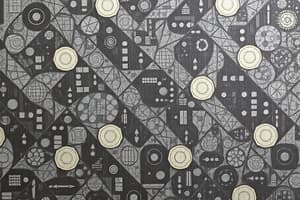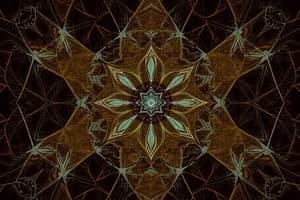Podcast
Questions and Answers
Which of the following is the BEST description of a pattern?
Which of the following is the BEST description of a pattern?
- A design that is always symmetrical.
- A predictable arrangement of elements. (correct)
- A form that only occurs in mathematics.
- An event that happens randomly.
Which of the following real-world scenarios does NOT exemplify the occurrence of patterns?
Which of the following real-world scenarios does NOT exemplify the occurrence of patterns?
- The seemingly random distribution of stars in a galaxy. (correct)
- The arrangement of petals in a flower.
- The alternating sequence of day and night.
- The layout of tiles on a floor.
Consider a series: 2, 6, 12, 20, __. What number logically follows in this series?
Consider a series: 2, 6, 12, 20, __. What number logically follows in this series?
- 24
- 28
- 32
- 30 (correct)
Find the missing number in the following sequence: 1, 1, 2, 3, 5, 8, ?
Find the missing number in the following sequence: 1, 1, 2, 3, 5, 8, ?
What is the core principle underlying the mathematical concept of symmetry?
What is the core principle underlying the mathematical concept of symmetry?
How many lines of symmetry does a regular pentagon possess?
How many lines of symmetry does a regular pentagon possess?
Which of the following implies that the image can still achieve the same appearance as the original position?
Which of the following implies that the image can still achieve the same appearance as the original position?
A figure has a rotational symmetry of order 4. Determine its angle of rotation.
A figure has a rotational symmetry of order 4. Determine its angle of rotation.
Which of the following is the MOST accurate definition of 'order of rotation'?
Which of the following is the MOST accurate definition of 'order of rotation'?
If a shape needs to be rotated $120$ degrees to achieve the same appearance as the original position, what is its order of rotation?
If a shape needs to be rotated $120$ degrees to achieve the same appearance as the original position, what is its order of rotation?
What packing structure enables you to cover most area efficiently and optimally?
What packing structure enables you to cover most area efficiently and optimally?
What is a packing problem MOST concerned with?
What is a packing problem MOST concerned with?
In square packing, if the area of the square is $4 \ cm^2$, what is the percentage of the square's area covered by circles?
In square packing, if the area of the square is $4 \ cm^2$, what is the percentage of the square's area covered by circles?
When comparing hexagonal and square packing, which statement is MOST accurate?
When comparing hexagonal and square packing, which statement is MOST accurate?
The area of a hexagon is $6\sqrt{3} \ cm^2$. If the total area is $3\pi \ cm^2$, what is the percentage of the hexagon's area covered by circles?
The area of a hexagon is $6\sqrt{3} \ cm^2$. If the total area is $3\pi \ cm^2$, what is the percentage of the hexagon's area covered by circles?
According to Alan Turing's theory on pattern formation, what underlying mechanism governs the creation of patterns like spots on hyenas and stripes on tigers?
According to Alan Turing's theory on pattern formation, what underlying mechanism governs the creation of patterns like spots on hyenas and stripes on tigers?
What term did Alan Turing use to identify the chemicals interacting inside the embryo of an animal?
What term did Alan Turing use to identify the chemicals interacting inside the embryo of an animal?
What is the name of the equation system used to model how the chemicals will diffuse through the embryo?
What is the name of the equation system used to model how the chemicals will diffuse through the embryo?
Which biological structure can be modeled using Fibonacci numbers?
Which biological structure can be modeled using Fibonacci numbers?
What does 'e' represent in the formula for modelling population growth?
What does 'e' represent in the formula for modelling population growth?
Given the formula $A = 30e^{0.02t}$, where A is in thousands and t is years after 1995, what was the population of the city in 1995?
Given the formula $A = 30e^{0.02t}$, where A is in thousands and t is years after 1995, what was the population of the city in 1995?
Given the exponential growth model $A = 30e^{0.02t}$, which represents the population (in thousands) t years after 1995, estimate the population in 2017.
Given the exponential growth model $A = 30e^{0.02t}$, which represents the population (in thousands) t years after 1995, estimate the population in 2017.
Which of the following statements best describes bilateral symmetry?
Which of the following statements best describes bilateral symmetry?
How does studying patterns contribute to making predictions?
How does studying patterns contribute to making predictions?
How does the arrangement of floor tiles display mathematical patterns in construction and design?
How does the arrangement of floor tiles display mathematical patterns in construction and design?
What is a key characteristic of patterns, as discussed in the context of mathematics in the modern world?
What is a key characteristic of patterns, as discussed in the context of mathematics in the modern world?
Flashcards
Patterns
Patterns
Regular, repeated, or recurring forms or designs in the world and mathematics.
Symmetry
Symmetry
An indication that an object can be divided by an imaginary line into mirror images.
Rotational Symmetry
Rotational Symmetry
A type of symmetry where a figure looks the same after a rotation.
Angle of Rotation
Angle of Rotation
Signup and view all the flashcards
Order of Rotation
Order of Rotation
Signup and view all the flashcards
Packing Problem
Packing Problem
Signup and view all the flashcards
Exponential Growth Model
Exponential Growth Model
Signup and view all the flashcards
Reaction-diffusion equations
Reaction-diffusion equations
Signup and view all the flashcards
Study Notes
- Jose Rizal Memorial State University's Department of Agricultural and Biosystems Engineering discusses Mathematics in the Modern World (Lec 2).
Patterns
- Patterns are regular, repeated, or recurring forms or designs found in nature and human endeavors.
- Examples include floor tile layouts, building designs, and shoelace tying methods.
- Studying patterns aids in identifying relationships, local connections, generalizations, and predictions.
Pattern Examples
- Figures can continue existing series.
- Numerical series follow a pattern to determine the next number.
- Identifying the number to replace a question mark within a grid of numbers requires finding a numerical pattern.
Symmetry
- Symmetry implies an imaginary line can be drawn across an object, resulting in mirror images.
- Butterflies, Leonardo da Vinci's Vitruvian Man, and starfish are examples of symmetry.
- Butterflies exhibit bilateral symmetry, where left and right portions are identical.
Rotational Symmetry
- Rotating a starfish by 72 degrees maintains its original appearance.
- Rotational symmetry is measured by the smallest angle that preserves the original position.
- The angle of rotation describes rotational symmetry.
- Order of rotation is another way of describing rotational symmetry.
- A figure has rotational symmetry of order n if 1/n of a complete turn leaves it unchanged.
- The formula to compute the angle of rotation is: Angle of rotation = 360° / n.
Example of Rotational Symmetry
- Snowflakes have a 6-fold symmetry, repeating its pattern six times.
- According to the calculation, the angle of rotation for a snowflake is 60°.
Honeycombs
- Bees use hexagons to build honeycombs.
- Hexagons cover more area compared to other polygons.
Packing Problem
- Packing problems involve finding the best method to fill a space, like a cubic or spherical container.
- A hexagonal structure covers more area.
Proof
- Circles with a 1 cm radius, have an area of π cm².
- A plane can be filled with these circles using square and hexagonal packing.
- For square packing, each square has an area of 4 cm² and can only fit one circle.
Coverage
- The percentage of a square's area covered by circles in square packing is approximately 78.54%.
- Hexagonal packing involves thinking of each hexagon as six equilateral triangles with 2 cm sides.
- The area of each triangle is √3 cm².
- The area of a hexagon is 6√3 cm².
- Three circles fit inside one hexagon, giving a total area of 3π cm².
- The percentage of the hexagon's area covered by circles is about 90.69%.
- Hexagons cover a larger area than squares.
Other Mathematics in Nature
- Alan Turing, stated that hyena spots and tiger stripes are formed by equations.
- Two chemicals, named morphogens, interact within an animal's embryo.
- These chemicals diffuse through the embryo, following "reaction-diffusion equations."
- Fibonacci numbers are found on flowers and nautilus shells.
- Mathematics can model population growth using the formula A = Pert, where A is the final population size, P is the initial population, r is the growth rate, t is time, and e is Euler's constant (approximately 2.718).
- Exponential growth can be described using the model A = 30e^0.02t, where A is thousands and t is years after 1995.
- In 1995 (t=0), the city population was 30,000.
- In 2017 (t=22), the city population is approximately 46,581.
Studying That Suits You
Use AI to generate personalized quizzes and flashcards to suit your learning preferences.




